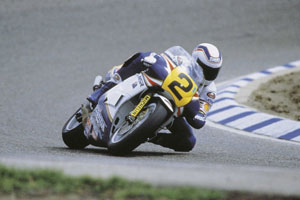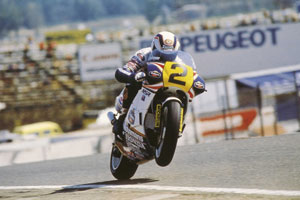Bike racing and equipment has come a long way since 1987 when Wayne Gardner won the world championship. We look back over 20 years at his NSR500.
It was brutally fast in a straight line and was a complete handful to steer around corners, but Wayne Gardner’s factory 1987 model Rothmans Honda NSR500 will be long remembered as one of the greatest motorcycles ever built and raced.
In its day, the NSR500 won many races and championships to be known as the king of two-stroke grand prix racing in the 1990s, and that reign of dominance was built off a platform from the men who developed it in the ’80s.
Guys like Freddie Spencer, Eddie Lawson and Gardner all put in the hard yards during a difficult time for Honda in that decade, with all three riders taming the incredible power enough to claim premier class titles for HRC in the ’80s.
The first four-cylinder NSR came in 1984 after Spencer won on the three-cylinder NS500 the year before, and it was a radical upside-down design that featured the fuel tank under the engine and exhaust pipes above.
Spencer won Honda’s first title with a V4 in ’85 before handing over the reigns to Gardner the following season where he would win three GPs on his way to second in the world title.
That winter, HRC did its homework to turn the NSR from a difficult beast into a bike that was at least rideable, with Gardner racing to his and Australia’s first 500GP world title in ’87 with seven race victories from 15 races.
Looking back to those years, the Wollongong Wiz will be the first to tell you what a wild ride it was back then on the snappy 190 horsepower missile, although he was always a rider to treat the bike with respect while riding it to its absolute limits.
“My 1987 NSR accelerated very hard and it obviously had very good top speed. In those days the bikes were 115 kilograms so it was very light and small. Those were the good memories,” Gardner reflects on his championship season.
“The acceleration was phenomenal, but very peaky. Carburation was very important on the Honda and throttle control was very delicate. We were using very high rpm.”
But it is the not so good memories that Gardner remembers best of the bike, as its traits of being hard to steer and unmistakeably snappy off of corners threw him down the road on a number of occasions.
“It was always very difficult to set up. The faster the straights the better it was for the ’87 NSR, for example, Hockenheim, but when it came to the small tight and twisty circuits with no long straights it was very hard to ride.
“This was primarily because the powerband was very peaky and it didn’t have much bottom end. You wouldn’t get any acceleration out of it under about 9,500rpm. It was very sensitive to gearing so that was a constant drama. It revved to about 13,500rpm although we could over-rev it to about 14,000rpm on downshifts.”
The steering of Gardner’s championship bike was its biggest downfall, as it was difficult to turn and keep on line, while he would have to be extremely careful of the massive power on corner exit.
“In that era Honda used to think that the lower the centre of gravity the better and they had a very low slung engine in that bike. Because of that, the bike had really bad understeer all the time — understeer means when you’re on the power it would just drift wide off line. We were constantly trying to get the bike to follow a line around a corner.”
“The Honda was very good on the brakes because of the low centre of gravity, but as I explained, when it come to the corners it just wanted to push wide. Its peaky power tended to want to highside you a lot of the time. It was a difficult bike to ride.”
While the bike was difficult to ride, it was still better than the previous year, and Gardner had adapted his style to make the most of the NSR’s power advantage, and learnt to ride around the steering problem.
“I realised it had the mid-corner understeer and it was difficult to keep on line, so I had to try to square the corners up. I had to rush in deep because it was good under brakes, and that’s where we were very strong, but it would be quite slow in the mid-corner because of the low centre of gravity,” he explains. “Then I had to try to get it stood up and wind it on hard to get the back when to break loose so it would turn the bike around and get it straightened up. That was my way to get it off the corner in a reasonable line, so I had to modify my riding style to suit that bike.
“Obviously it was very spectacular because people loved watching me do it, but it was the only way to get that pig around a corner [laughs].”
Honda’s NSR500 became known as the bike to be on, as its power advantage looked like an easy winner from the sidelines, but its handling made it a completely different story once in the saddle.
“It was known for its straight line speed, but it was also known for its terrible handling and mid-corner speed. There were numerous riders, for example, Niall Mackenzie and Carl Fogarty, in that period who rode those bikes, but nobody could ride them because you couldn’t hold corner speed on it.
“The only reason why I coped with it was because I adapted my riding style to get some corner speed out of it. It was known for its bad handling and everyone used to scratch their heads and not really know how I did it. It was just a case of working out its strengths and weaknesses — focusing on its strengths and to be very careful of its weaknesses.”
Gardner was very careful indeed (to an extent), taking full advantage of its top speed and awesome acceleration, yet being fully aware of its steering faults. He won the title over Yamaha riders Randy Mamola and Lawson, whose bikes weren’t as fast, but handled extremely well.
“Its acceleration and top speed, no doubt, were the strong points of the NSR. It had a good jump on everybody so Yamaha was working really hard to get some speed out of their bikes, but their bikes were more manageable and rideable than ours.”
As Yamaha looked for horsepower, Honda looked to solve its handling problems, and it wasn’t until two years after Gardner won the crown that they finally worked out what was wrong.
“We were trying to go the other way, trying to get the bike to steer and trying to get it to handle. But in those days Honda had the wrong theory. They didn’t work that out until the end 1989 because they saw the [well handling] Suzuki undressed one time and got photos of it from my motorhome. They blew them up and had a look where all their engine positions were and it was completely different to the theory Honda had.”
Gardner pushed himself and the NSR to the limits to try to solve the handling woes, and it was those pictures in 1989 that finally gave HRC direction to raise the engine in the chassis to help steering with a higher centre of gravity, although Gardner’s championship came on the ill handling weapon.
“I only got on the four-cylinder from 1986 onwards because I inherited it, in a sense, from Spencer, so I was just following what they were doing. We were confused because I couldn’t get the thing to go around corners and when you did try to force it then it tended to highside you. That’s why I had a lot of crashes. From ’86 to ’89 the bike was a pig.”
Meanwhile, for Gardner’s championship winning year in 1987, Honda had tried to fix the understeer problem by reversing the crankshaft rotation, hoping that would eliminate the front-end push mid-corner.
This was done because Yamaha had a twin cranks that were counter-rotating, meaning they didn’t have to worry about any gyro effect. HRC believed that was the reason the Yamaha was a better handling motorcycle.
“I was constantly whinging to Honda that we can’t get around corners and that I can’t follow the Yamaha because they just go around corners and would get on the gas and be gone,” says Gardner. “I had to stand the bike up, square the corner up, and fire it off the corner that way.
“Honda thought the reason for that was because the NSR had one crankshaft, while the Yamaha had two, so then they started reversing the rotation of the crankshaft to see if that would change it. We did that for a while and actually had the crankshaft spinning in reverse and that didn’t really work. Honda finally realised they were on the wrong path and should have had the engine up higher in the chassis.”
Although the Honda didn’t quite handle as well as the other bikes on the grid, Gardner used his determination and aggression to capture the sports ultimate crown on a bike that nobody else could hardly ride.
His never-say-die style captured the attention of fans and rival teams, and he used the power and braking capabilities to outclass the other riders in the series, even though they could get through the turns much more efficiently.
“I would make most of my passes under brakes and in straight line speed, absolutely. Long flowing corners is where we really struggled, but tight corners where you brake, turn it and get out of there, we were very strong.
“They would usually pass me through corners. I would have to park it through corners because it didn’t want to steer, but as I said, as soon as I could get that bike around the corner and past the apex I was gone.”
The bike went backwards for two more seasons after Gardner’s triumph in 1987, as he placed second in ’88 with four wins and plenty of spills, before Yamaha’s reigning champion Lawson captured the ’89 title on one of the most evil GP bikes ever.
Known as one of the most lethal bikes of the 1980s, the NSR500 transformed into one of the most dominant bikes ever in the ’90s. This was partly due to those Suzuki photo taken from the Wiz’s motorhome in late ’89, and taken further by the big-bang engine that was introduced in ’92 — Gardner’s last season of racing.
“The Honda only started to get good in around 1991 and ’92. It was a very frustrating bike to ride until then and I still say to this day that I could have won more titles if I had a bike that handled better and I probably would have had less crashes,” he says looking back. “I didn’t know at the time and I was just trying to deal with what I had, but I constantly asked after every year for a better handling bike.”
Gardner believes he, along with the other Honda riders in the late ’80s, played major roles in the NSR’s success story throughout its entire lifespan, and he was the one who pushed hard for the big-bang engine.
“Absolutely we built the platform of the NSR. Once we got the chassis right in 1991 and ’92, they introduced the big-bang engine in ’92, and I was a very big supporter of the big-bang engine. I was a major part of the development of the NSR because I rode it all of those years.”
With championships won by the likes of Spencer, Gardner, Lawson, Mick Doohan, Alex Criville and Valentino Rossi, the Honda NSR500 will forever be know as a grand prix legend.








